Japanese
English
- 有料閲覧
- Abstract 文献概要
- 1ページ目 Look Inside
- 参考文献 Reference
麻酔薬の厳密な定義はないが,全身麻酔薬は無意識および無記憶が得られ,かつ投与を終了すれば程なくもとの状態に回復することは必須である。麻酔薬はほかの薬物と異なり多くのチャンネルや受容体に作用する。現在のところ意識の本態は解明されていないが,脳の特定の部位に存在するのではなく,大脳皮質間の連携のうえに存在するというTononiの説が有力である。麻酔薬はこの大脳皮質間の連携を分断する作用がある。麻酔薬は無意識となるよりも低い濃度で記憶を抑制するが,潜在性記憶はさらに高い濃度でも残り得る。麻酔薬には抗侵害受容作用はなく,臨床では麻酔薬と鎮痛薬を組み合わせたバランス麻酔が行われている。
It is essential that general anesthetics produce unconsciousness and amnesia, and that they allow restoration of the patient's normal state shortly after termination of administration, although there is no strict definition of “anesthetics”. Unlike most other drugs, anesthetics act on a large number of channels and receptors. At present, the mechanism for consciousness has not been clarified. Recently, Tononi's theory that consciousness is not located in a specific part of the brain, but rather in the connection of each part of the cerebral cortex, has gained acceptance. Anesthetics interrupt the inter-cortical connections and produce unconsciousness. Anesthetics suppress memory at concentrations lower than unconsciousness, but implicit memories can persist at even higher concentrations. Anesthetics do not have antinociceptive effects, therefore balanced anesthesia, a combination of anesthetics and analgesics, is used in clinical practice.

Copyright © 2021, MEDICAL SCIENCES INTERNATIONAL, LTD. All rights reserved.


